Theory Test Vulnerable Road Users
To learn all about the Vulnerable Road Users category, watch the video or read the article below.
The theory test featuring questions from this category is at the bottom of the page.
Topics Include
- Animals – understanding that animals can be unpredictable and may move slowly.
- Motorcyclists – be aware of their presence on the road.
- Elderly Drivers – be aware that they may be slower to make decisions
- Children – be aware that they are particularly unpredictable on and around roads.
- Pedestrians – be aware of their actions as they cross the road.
- New Drivers – understanding that they may be more hesitant, allow for this and be patient.
- Cyclists – be aware that they may swerve to avoid obstructions and are often affected by weather conditions.
Again safety is the main concern and this should inform your choice of answers.
Vulnerable Road Users are
- Pedestrians
- Children
- Older drivers
- Disabled drivers
- Cyclists
- Motorcyclists
- Animals
- New drivers
No question is going to have ‘speed up’ as an answer. Questions dealing with how you should interact with vulnerable road users usually require a stay behind, give plenty of room, slow down, be prepared to stop and give way type of answer. No answer will be: sound your horn, flash your headlights or wave them across.
Motorcycles and Cyclists
- Are small and hard to see. Always look out for them at junctions.
- At roundabouts, if a cyclists is turning right, give them plenty of room.
- Never overtake a motorcyclist and cyclists just before turning left.
- If you see a cyclist approach a roundabout in the left-hand lane don’t just expect them to be turning left, they may go in any direction.
- When turning right check for motorcyclists as one may be overtaking you.
- When overtaking a cyclist allow as much room as you would give to a car.
- Motorcyclists wear bright clothing and often use a dipped headlight during the day, as this makes them easier to see.
- When following a slow-moving motorcyclist if you are unsure what the rider is going to do you should stay behind.
- Motorcyclists are particularly vulnerable at junctions.
- On an uneven road give motorcyclists extra room as they may swerve into the road to avoid potholes.
- In slow moving traffic, if you intend to change lane you should look for motorcyclists filtering through the traffic.
- A motorcyclist may look over their shoulder when turning right because they need to check for traffic in their blind area.
- Cyclists and motorcyclists are vulnerable to strong winds which can blow them off course. On windy days always allow extra room when overtaking them.
- Cycle lanes marked with a solid white line – you must not drive or park in the cycle lane during the hours it is in use.
- Cycle lanes marked with a broken white line – you should drive or park in it only if there is no alternative, but not at times when there are waiting restrictions.
Pedestrians
- Always give way to pedestrians who have already started to cross a road. If you turn into a road and people are crossing it you must stop, wait and let them cross.
- Toucan Crossings – cyclists can use these as well as pedestrians. So, ‘2 can’ cross.
- A pedestrian with a white stick and a red band is deaf and blind.
- Be patient with elderly pedestrians. Allow them time to cross the road. Be careful, they may misjudge your speed.
- On country roads pedestrians should walk towards you on your side of the road.
- At night a pedestrian who is wearing reflective clothing and carrying a bright red light is leading an organized walk.
- Children are especially hard to see. Take extra care when reversing and when traveling along roads where there are many parked cars.
Horses and Animals
- At a roundabout, if horses are ahead of you you should give them plenty of room and be prepared to stop. If they are approaching the roundabout in the left hand-lane but are signaling right, you should stay well back.
- When passing horses you should slow down and allow plenty of room.
- When passing sheep you should allow plenty of room, go very slowly, be ready to stop. If you do stop, turn off your engine and wait until they have left the road.
Inexperienced and Elderly Drivers
- Always be patient with elderly and inexperienced drivers. Expect them to react more slowly.
Others Facts to Know
- Whenever turning right always check your mirrors to make no one is about to overtake you.
- Powered vehicles used by disabled people have a flashing amber beacon, which indicates a slow moving vehicle.
- A pedestrian walking with a dog that has a yellow or burgundy coat is likely to be deaf.
- A person carrying a white stick is likely to be blind. If the stick has a red band, this means the person is also deaf.
- When approaching any pedestrian crossing be prepared to slow down and stop.
- At night, if dazzled by vehicles behind, you should set your mirror to anti-dazzle.
- Give way to buses when they signal to pull out.
- Always give way to trams as they cannot steer to avoid you.
- When elderly people are crossing the road be patient and allow them to cross in their own time.
Signs to Know
Road marking outside a school. You should not wait or park here, as you may obstruct children’s view of the crossing area.
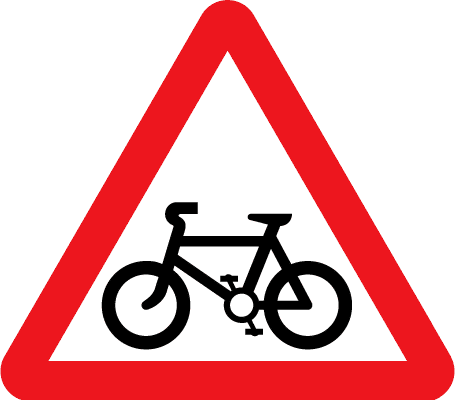
Cycle route ahead
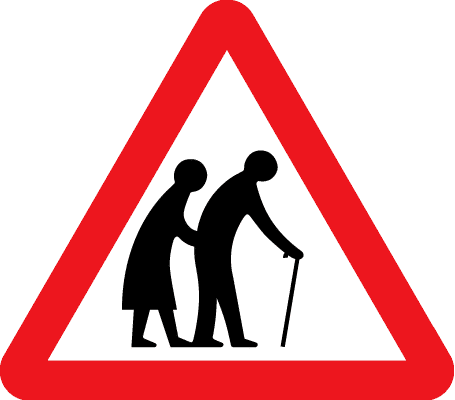
Elderly people crossing
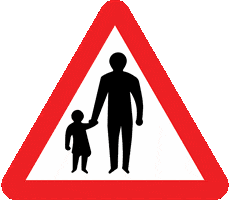
Pedestrians my be walking in the road as there is no pavement
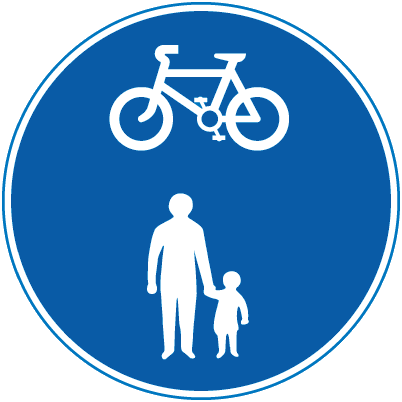
A route for pedestrians and cyclists

Sign found on school bus
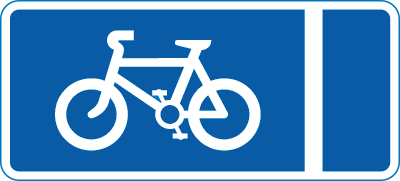
With-flow pedal cycle lane.
